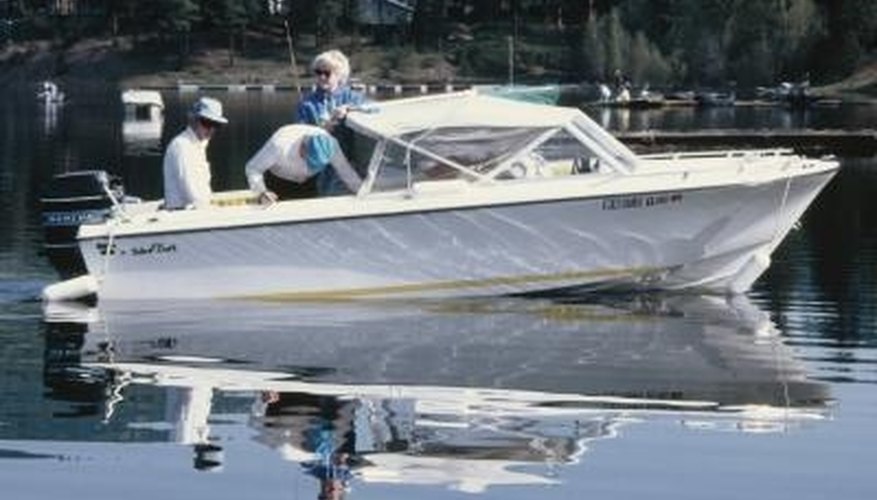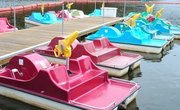
Chips and dents in the shiny hull of your fiberglass boat will happen. Debris in the water and loading and unloading from trailers can contribute to the collection of dings and dents that mar your boat's finish. The good new is that you can fix minor damage without having to redo the entire boat from stem to stern. The process takes some care, but it's well within the capabilities of most do-it-yourselfers.
Items you will need
Gelcoat mix
Gelcoat color tints and chart
MEKP: catalyst
Gelcoat paste
Stirring stick
Rotory motor tool
Mixing container
Masking tape
Newspaper and paper towels
Acetone
Plastic putty knife or flat applicator
Orbital sander
Wet/dry sandpaper, 80, 320, 400 and 600 grit
Buffing compound
Buffer
Protective gloves
Eye protection
Step 1
Cover undamaged areas of the hull close to the area to be repaired with newspaper. Mask the edges with tape. Use the rotary tool and a pointed grinding bit to dig out the damaged gelcoat. Bevel the edges around the damaged area and grind away the damaged part down to the fiberglass. Be careful not to gouge the fiberglass.
Step 2
Roughen the surface in and around the chip or dent with 80-grit sandpaper to give the gelcoat a rough surface to adhere to. Blow out the dust from the repair area and blot it clean with acetone. Allow the damaged area to dry thoroughly. Fill pronounced scratches or dents with gelcoat paste and use the plastic putty knife to level the surface of the repair area just below the hull to allow room for a coat of gelcoat. Follow the directions on your particular paste mixture. Allow it to cure thoroughly.
Step 3
Mix a small amount of gelcoat in your mixing container according to manufacturer's directions. Add color tint solutions in the proportions and shades suggested by the color matching chart that comes with the tint colors.
Step 4
Add the MEKP catalyst as directed. Be sure to get the catalyst proportions right. Too much will prevent the gelcoat from hardening and create air bubbles. Too little can increase drying time.
Step 5
Fill the damaged area with about 25 percent more gelcoat than you need, to allow for shrinkage. Allow the gelcoat to cover slightly outside the repair area so that all the edges are fully covered. Pop any air bubbles that form with a sharp tool or knife point.
Step 6
Wait at least four hours for the gelcoat to harden. Meanwhile clean up any mess with acetone and paper towels. Allow the repair to cure overnight before sanding.
Step 7
Wipe down the repaired area with acetone and a rag to remove any tackiness. Tape around the edges of the new gelcoat to protect the existing hull. Sand the repaired area with increasingly fine grades of wet/dry sandpaper, starting with 320, then 400 with the orbital sander till you get level with the old hull. Remove the masking tape and use 600-grit sandpaper and sand with a rubber sanding block or by hand to blend the repair and the original hull surface. Don't sand through the new gelcoat. This will leave discolored spots in the repair. Feather the edges of the repair into the surrounding hull area so that the edges don't show.
Step 8
Apply buffing compound and buff smooth with a buffer. It may take three or four passes with the buffer to polish the repair smooth. Finish by waxing the entire boat so the shine is even, and the repair should be virtually invisible.
Warnings
- Handle the MEKP catalyst carefully. It is caustic and if it gets in your eyes it can blind you.
- Always wear gloves and eye protection when handling fiberglass chemicals and solvents.
References
Warnings
- Handle the MEKP catalyst carefully. It is caustic and if it gets in your eyes it can blind you.
- Always wear gloves and eye protection when handling fiberglass chemicals and solvents.
Writer Bio
Tom King published his first paid story in 1976. His book, "Going for the Green: An Insider's Guide to Raising Money With Charity Golf," was published in 2008. He received gold awards for screenwriting at the 1994 Worldfest Charleston and 1995 Worldfest Houston International Film Festivals. King holds a Bachelor of Arts in communications from Southwestern Adventist College.



